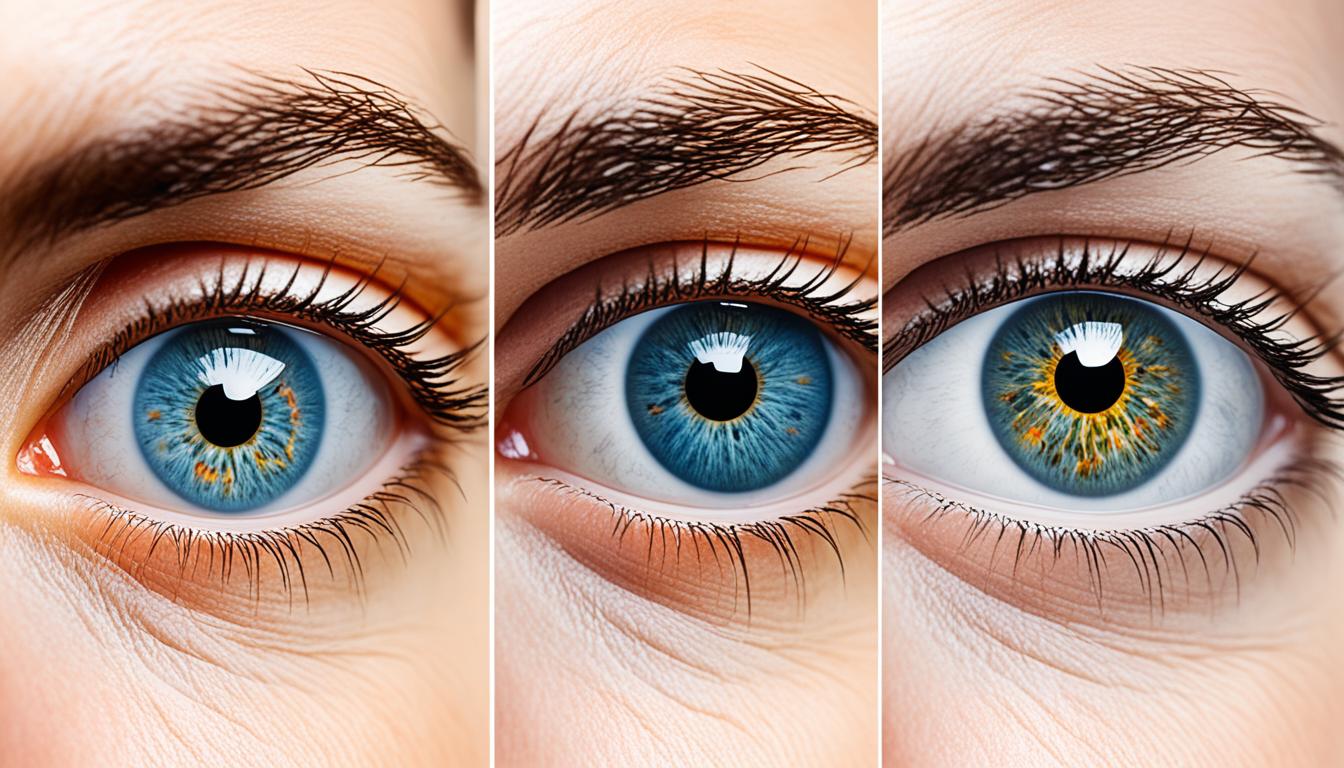Macular degeneration, or AMD, is a common eye sickness. It harms the macula, needed for sharp vision. There are two main types: dry and wet.
Wet AMD, a severe type, sees abnormal blood vessel growth. This growth can lead to vision loss. Without proper care, vision may severely decline.
Key Takeaways:
- Macular degeneration affects the macula, causing vision loss.
- Its types are dry and wet.
- Wet AMD is known for abnormal blood vessel growth.
- Early care is crucial to save vision.
- Stem cell therapy offers hope for wet AMD treatment.
Symptoms and Causes of Wet Macular Degeneration
Wet macular degeneration is an eye disease that worsens over time. It can really harm your vision. Knowing the signs and what causes it is key to catching it early and getting help when needed.
Symptoms of Wet Macular Degeneration
If you have wet macular degeneration, you might notice some key problems with your vision:
- Blurred or distorted central vision
- Difficulty reading or recognizing faces
- Seeing straight lines as wavy or crooked
These issues make daily tasks hard and can lower your life quality. If you see these signs, visit your doctor right away for tests and advice.
Causes of Wet Macular Degeneration
We do not fully know what causes wet macular degeneration. But, it seems a mix of genes and things around you might lead to it. As you get older, your chances of getting it go up. Some other things that could up the risk are:
- Smoking
- Too much time in the sun
- Bad eating habits
- High blood pressure
- Obesity
- Not enough exercise
Remember, these things by themselves don’t cause wet macular degeneration. They might just make it worse. Changing to a healthier lifestyle, not smoking, and protecting your eyes from the sun might lower these risks.
Next, we’ll delve into how doctors diagnose and treat wet macular degeneration to help you manage it better.
Diagnosing Wet Macular Degeneration and Available Treatments
It’s vital to diagnose wet macular degeneration early for timely care. A full eye test is the first step. This test checks your eyes for any issues. Each of the following steps is important:
- First is the Visual Acuity Test. It checks how clearly you can see, especially in the center of your vision.
- Next, a Dilated Eye Exam lets the doctor see the back of your eye clearly. This is done by widening your pupils. It helps find any abnormal blood vessels on the retina.
- Then, there are Imaging Tests such as:
- Optical Coherence Tomography (OCT). It’s a type of scan that shows detailed pictures of your eye. This helps spot wet AMD.
- Also, there’s Fluorescein Angiography. A dye is put into your arm and shows leaky blood vessels in your eye. It helps the doctor see the problem clearly.
After diagnosis, finding the right treatment to stop more vision loss is key. The main therapy used is called anti-VEGF.
Anti-VEGF therapy means getting special medicine injected into your eye. This stops abnormal blood vessels from growing more. The treatment is done by a doctor on a set schedule. It helps prevent losing more sight and might even make your vision better.
Besides anti-VEGF, new treatments are being looked into. These include gene therapy and stem cell therapy:
- Gene therapy: It tries to put healthy genes in your eye to fix bad ones. This could stop or turn back the disease.
- Stem cell therapy: It puts new cells in your eye to replace the old, damaged ones. This could help you see better. This area of study is promising for the future of wet AMD treatment.
It’s exciting to see what gene and stem cell therapies could offer. But remember, they’re still in early stages of research. They aren’t common treatments yet.
In the end, diagnosing wet macular degeneration includes a detailed eye check and tests. Right now, anti-VEGF is the top treatment, helping manage the disease well. Continued research is bringing us closer to treatments like gene and stem cell therapies. These new options give hope to those fighting wet AMD.
| Treatment Options | Advantages | Considerations |
|---|---|---|
| Anti-VEGF Therapy |
|
|
| Gene Therapy |
|
|
| Stem Cell Therapy |
|
|
Conclusion
Living with wet macular degeneration (AMD) is challenging, but there’s hope. Treatments have improved a lot. It’s crucial to diagnose it early and treat any vision loss properly.
To manage this condition, regular eye checks are a must. Lifestyle changes also play a big role in coping with wet AMD.
The main treatment today is anti-vascular endothelial growth factor (anti-VEGF) therapy. Special eye injections help slow down vision loss. In some cases, they even improve your sight.
Stem cell therapy could offer new treatment options in the future. This kind of therapy might even help restore lost vision for some people.
People with wet AMD should always be on top of their eye health. By working with your doctors and following treatment plans, you can keep the disease under control. This helps you make the most out of your remaining vision.
Though living with wet AMD is tough, there is always reason to hope. With ongoing advances in treatment and research, a brighter future is possible for everyone affected by this condition.

